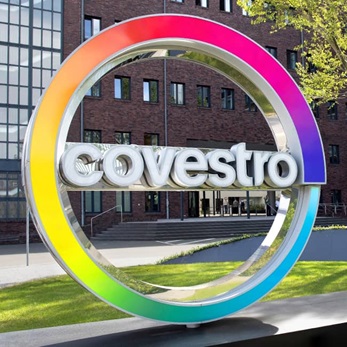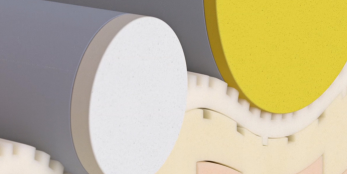Before working with this product, you must read and become familiar with the available information on its risks, proper use, and handling. Information is available in several forms, e.g., in particular in the currently valid safety data sheets and product labels. For further information contact your Covestro representative.
Product description
Texin 950D resin is an aromatic polyether-based thermoplastic polyurethane with a Shore hardness of approximately 50D*. It can be processed by injection molding, extrusion, or blow molding.
Applications
Texin 950D resin offers outstanding abrasion resistance, impact strength, toughness, and flexibility. It also exhibits excellent inherent resistance to salt water stress cracking, and hydrolysis. Texin 950D natural color resin complies with FDA food-contact regulations 21 CFR 177.1680 (Polyurethane Resins) and 177.2600 (Rubber Articles Intended for Repeated Use), subject to the limitations of these and any other applicable regulations. In addition, Texin 950D natural color resin is listed under NSF standard 61 for use in potable water applications. Typical applications include gaskets, hose, tubing, shoe inserts, connectors, belting, and miscellaneous molded articles. As with any product, use of Texin 950D resin in a given application must be tested (including but not limited to field testing) in advance by the user to determine suitability.
Storage
Texin thermoplastic polyurethane resins are hygroscopic and will absorb ambient moisture. The presence of moisture can adversely affect processing characteristics and the quality of parts. Therefore, the resins should remain in their sealed containers and be stored under cool and dry conditions until used. Storage temperature should not exceed 86°F (30°C). Unused resin from opened containers, or reground material that is not to be used immediately, should be stored in sealed containers.
Processing
Prior to processing, Texin 950D resin must be thoroughly dried in a desiccant dehumidifying hopper dryer. Hopper inlet air temperature should be 190°–220°F (88°–104°C). To achieve the recommended moisture content of less than 0.03%, the inlet air dew point should be -20°F (-29°C) or lower. The hopper capacity should be sufcient to provide a minimum residence time of 4 hours. Additional information on drying procedures is available in the brochure - General Drying Guide.
Texin 950D resin may be easily processed on commercially available equipment suitable for injection molding of thermoplastic polyurethane elastomers. The recommended screw length-to-diameter (L/D) ratio is 20:1 with a compression ratio of 2.5–3:1. Screws with a compression ratio greater than 4:1 should be avoided. Recommended shot weight is 40–80% of rated barrel capacity. To obtain good clarity in parts, Texin 950D resin must be molded on tools with a highly polished chrome surface. Typical starting conditions are noted below. Actual processing conditions will depend on machine size, mold design, material residence time, etc.
Additional information on injection molding may be obtained by consulting the publication - Texin and Desmopan Thermoplastic Polyurethanes — A Processing Guide for Injection Molding and by contacting a Covestro technical service representative.
Texin 950D resin possesses a satisfactory melt strength and can be controlled over a wide range of temperature conditions to produce tubing, sheet, and extruded profiles. Typical starting conditions are noted below. Actual processing conditions vary and are dependent on size of extruders, extrusion rate, part geometry, etc.
The preferred screw design should have a compression ratio of 3:1 and should feature a long, gradual transition zone and a long meter zone. The recommended length- to-diameter (L/D) ratio is at least 24:1. Typical recommendations for 3:1 compression ratio screws on various sizes of 24:1 L/D extruders are given in the table below. Additional information on extrusion may be obtained by consulting the publication - Texin and Desmopan Thermoplastic Polyurethanes - A Processing Guide for Extrusion and by contacting a Covestro technical service representative.
Where end-use requirements permit, up to 20% Texin resin regrind may be used with virgin material, provided that the material is kept free of contamination and is properly dried (see section on Drying). Any regrind used must be generated from properly molded/extruded parts, sprues, runners, trimmings, and/or films. All regrind used must be clean, uncontaminated, and thoroughly blended with virgin resin prior to drying and processing. Under no circumstances should degraded, discolored, or contaminated material be used for regrind. Materials of this type should be properly discarded. Improperly mixed and/or dried regrind may diminish the desired properties of Texin resin. It is critical that you test finished parts produced with any amount of regrind to ensure that your end-use performance requirements are fully met. Regulatory or testing organizations (e.g., Underwriter';s Laboratories) may have specific requirements limiting the allowable amount of regrind. Because third party regrind generally does not have a traceable heat history or offer any assurance that proper temperatures, conditions, and/or materials were used in processing, extreme caution must be exercised in buying and using regrind from third parties. The use of regrind material should be avoided entirely in those applications where resin properties equivalent to virgin material are required, including but not limited to color quality, impact strength, resin purity, and/or load-bearing performance.
* This table shows property changes for Texin 950D resin after exposure to hot air, oil, and fuel. As is the case with any compatibility test, the results are dependent on variables, such as concentration, time, temperature, part design, and residual stresses, and should serve only as a guideline. It is imperative that production parts be evaluated under actual application conditions prior to commercial use.
Health and Safety Information
Disclaimer
General
The manner in which you use our products, technical assistance and information (whether verbal, written or by way of production evaluations), including any suggested formulations and recommendations, are beyond our control. Therefore, it is imperative that you test our products to determine suitability for your processing and intended uses. Your analysis must at least include testing to determine suitability from a technical, health, safety, and environmental and regulatory standpoint. Such testing has not necessarily been done by Covestro, and Covestro has not obtained any approvals or licenses for a particular use or application of the product.
Unless we otherwise agree in writing, all products are sold strictly pursuant to the terms of our standard conditions of sale which are available upon request.
All information and including technical assistance is given without warranty or guarantee and is subject to change without notice. It is expressly understood and agreed by you that you assume and hereby expressly release indemnify us and hold us harmless from all liability, in tort, contract or otherwise, incurred in connection with the use of our products, technical assistance, and information. Any statement or recommendation not contained herein is unauthorized and shall not bind us. Nothing herein shall be construed as a recommendation to use any product in conflict with any claim of any patent relative to any material or its use. No license is implied or in fact granted under the claims of any patent.
Non Medical and non Food Contact
This product is not designated for the manufacture of a medical device or of intermediate products for medical devices (1). This product is also not designated for other specifically regulated applications (e.g. including cosmetics, plant protection, fertilisers, plant strengtheners, food processing, food contact and others). If the intended use of the product is for the manufacture of a medical device or of intermediate products for medical devices or for other specifically regulated applications Covestro must be contacted in advance to provide its agreement to sell such product for such purpose. Nonetheless, any determination as to whether a product is appropriate for use in a medical device or intermediate products for medical devices, for Food Contact products or cosmetic applications must be made solely by the purchaser of the product without relying upon any representations by Covestro.
1) Please see the Guidance on Use of Covestro Products in a Medical Application document.
Sample
Any samples provided by Covestro are for testing purposes only and not for commercial use.
Typical Value
These values are typical values only. Unless explicitly agreed in written form, they do not constitute a binding material specification or warranted values. Values may be affected by the design of the mold/die, the processing conditions and coloring/pigmentation of the product. Unless specified to the contrary, the property values given have been established on standardized test specimens at room temperature.
Contact Information
Please use our contact form or contact us directly by sending an e-mail to technical-datasheets@cx.covestro.com .








